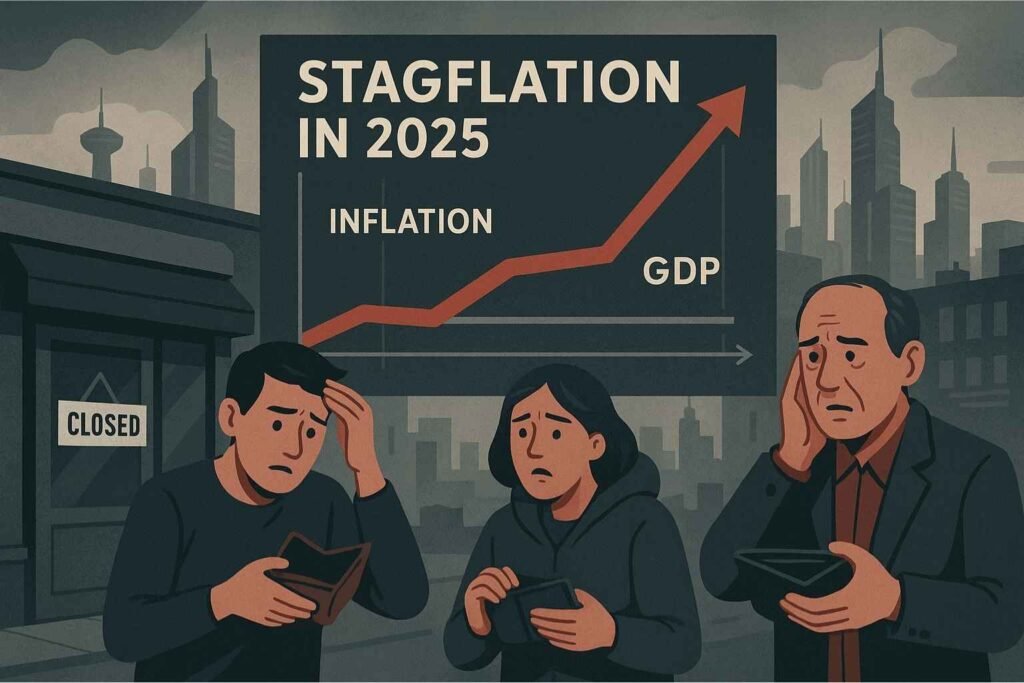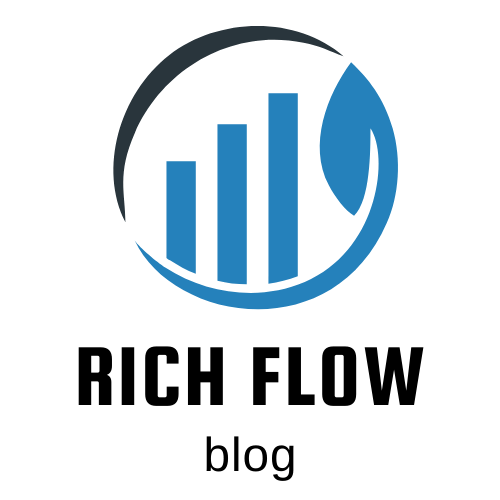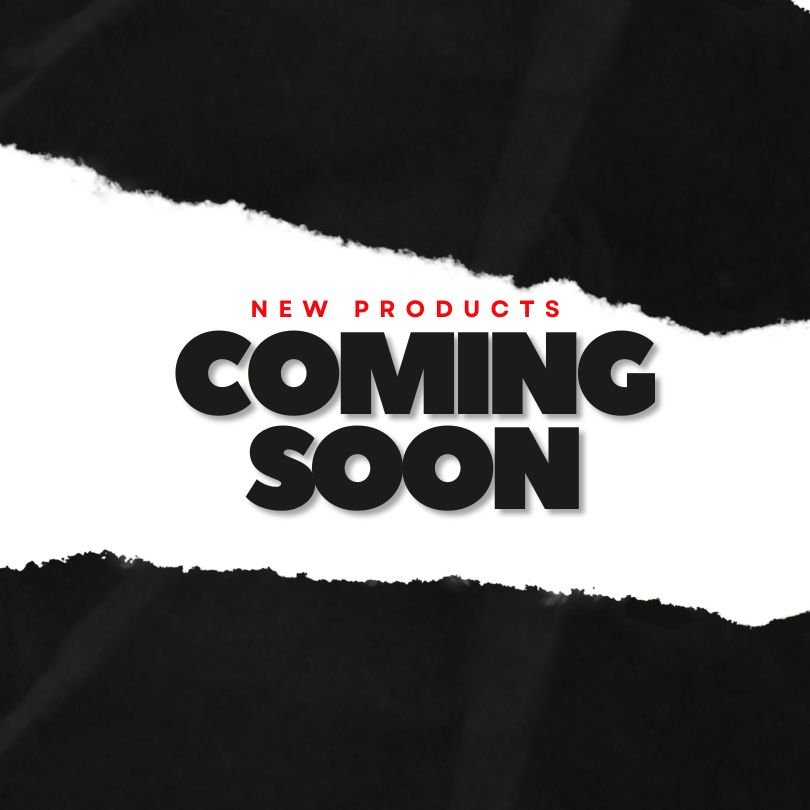
In early 2025, a concerning economic term has re-entered our collective vocabulary: stagflation. This economic phenomenon, characterized by the toxic combination of stagnant growth, high unemployment, and persistent inflation, has investors and consumers alike searching for answers and protection strategies.
The prospect of stagflation poses unique challenges that traditional economic policies struggle to address. Unlike typical recessions or inflation-only scenarios, stagflation creates a painful double bind that can erode savings while limiting job opportunities and income growth.
But what exactly is causing these concerns in 2025, and how similar is our current situation to the infamous stagflation of the 1970s? More importantly, what practical steps can you take to safeguard your finances if stagflation takes hold?
What Is Stagflation and Why Is It So Concerning?
Stagflation combines three harmful economic conditions that rarely occur simultaneously:
- High inflation – Rising prices across the economy
- Stagnant economic growth – Flat or declining GDP
- High unemployment – Increasing joblessness or underemployment
What makes stagflation particularly troublesome is that these conditions create a policy dilemma. As economist Şebnem Kalemli-Özcan of Brown University explains, “Stagflation is a very, very hard scenario for a central banker” because traditional remedies for one problem can worsen the others.
For example, when the Federal Reserve raises interest rates to combat inflation, it risks further slowing economic growth and increasing unemployment. Conversely, stimulating the economy to boost growth and employment can fuel additional inflation.
The 2025 Stagflation Risk: What’s Driving Concerns?
The current stagflationary concerns in 2025 stem from several key factors:
1. Tariff Policy Uncertainty
In March 2025, the Trump administration implemented significant new tariffs on imported goods. Federal Reserve Chair Jerome Powell acknowledged that these tariffs were “significantly larger than expected” with likely effects that included “higher inflation and slower growth” – the classic precursors to stagflation.
Economists point out that tariffs function similarly to supply shocks, raising prices across supply chains while potentially limiting economic output. The uncertainty surrounding these policies has further complicated business planning and investment.
2. Weakening Economic Growth
Recent economic data has raised red flags. According to the Atlanta Fed’s real-time GDP estimate in early 2025, economic activity was projected to shrink at a 0.5% rate in Q1, while consumer spending fell by the most in nearly four years during January, following a robust holiday season.
3. Persistent Inflation
While inflation had been trending downward from its pandemic-era peaks, price increases have remained stubbornly above the Federal Reserve’s 2% target. The Fed’s preferred inflation gauge, the Personal Consumption Expenditures (PCE) price index, showed inflation at 2.6% in January 2025, indicating that progress on taming inflation had stalled.
4. Eroding Consumer Confidence
Consumer sentiment has weakened amid inflation concerns and economic uncertainty. The University of Michigan’s consumer sentiment survey showed Americans growing more pessimistic about the economic outlook in 2025, with respondents reporting being “less secure about their jobs and more worried about inflation down the road.”
How Today’s Situation Compares to the 1970s Stagflation
While concerns about stagflation are legitimate, it’s important to understand how our current situation differs from the severe stagflation of the 1970s:
Key Differences
- Energy Independence: Unlike the 1970s, when OPEC controlled nearly 60% of the world’s oil supply, the U.S. is now far less vulnerable to oil shocks as a net energy exporter.
- Federal Reserve Credibility: Today’s Federal Reserve has established far stronger anti-inflation credibility since the Volcker era of the early 1980s when interest rates were pushed to nearly 21% to break inflation.
- Labor Market Structure: Union membership has declined significantly since the 1970s, weakening the wage-price spiral dynamics that contributed to persistent inflation then.
- Severity of Current Indicators: The “misery index” (inflation rate plus unemployment rate) peaked at over 20% in the late 1970s. In early 2025, this index remains much lower, despite concerns about its trajectory.
Key Similarities
- Supply Shocks: Just as the oil crisis disrupted supply chains in the 1970s, recent tariff policies are creating supply-side pressures throughout the economy.
- Policy Uncertainty: Both periods feature significant shifts in economic policy that created uncertainty for businesses and consumers.
- Global Context: Both eras feature international tensions and disruptions to global trade that complicate domestic economic management.
How to Protect Your Finances from Stagflation
If stagflation risks continue to grow in 2025, there are concrete steps you can take to protect your financial wellbeing:
For Investors: Stagflation-Resistant Investment Strategies
1. Diversify with TIPS (Treasury Inflation-Protected Securities)
TIPS are government securities specifically designed to protect against inflation. Their principal value adjusts with changes in the Consumer Price Index, ensuring your investment maintains purchasing power even as prices rise.
As financial advisor Michael Rosen explains, “TIPS are better suited for retirement accounts since you are taxed on accrued interest that you don’t actually receive until maturity.”
2. Consider Value Over Growth Stocks
During stagflation, companies with strong earnings, low debt, and essential products often outperform high-growth companies that rely on future earnings potential.
Historically, defensive sectors like consumer staples, healthcare, and utilities have performed better during stagflationary periods than growth-oriented technology or discretionary consumer sectors.
3. Real Assets as Inflation Hedges
Real estate investments, including rental properties and REITs (Real Estate Investment Trusts), can provide both income and inflation protection, as property values and rents typically rise with inflation.
Other tangible assets worth considering include:
- Commodities: Resources like precious metals, agricultural products, and industrial metals often maintain value during high inflation periods
- Infrastructure investments: Essential services with regulated, inflation-adjusted returns
4. Shorten Bond Duration
Long-term bonds can suffer significantly during inflation, as their fixed interest payments lose purchasing power over time. Consider shifting some fixed-income investments toward shorter-duration bonds that are less sensitive to inflation and rising interest rates.
🚨 Have you heard about Genius Wave? A simple 7-minute audio that can reprogram your brain to boost focus, productivity, and even attract more opportunities. Click here to see how it works. It’s not magic — it’s applied neuroscience. Give your potential a real chance!
For Consumers: Practical Stagflation Defense Tactics
1. Reduce High-Interest Debt
Prioritize paying down variable-rate debt like credit cards before a potential stagflationary period. In an environment where jobs may become less secure while the cost of living rises, having fewer fixed financial obligations provides crucial flexibility.
2. Build Emergency Savings
Financial experts typically recommend having 3-6 months of expenses saved, but during economic uncertainty, consider increasing this to 6-9 months if possible. This provides a longer runway if employment becomes unstable.
3. Develop Multiple Income Streams
Diversifying your income sources can provide critical protection if your primary job is affected by economic stagnation. Consider:
- Freelance work in your field
- Starting a small side business
- Part-time work in essential industries that remain stable during economic downturns
- Passive income investments that generate cash flow
4. Consider Fixed-Rate Financing for Major Purchases
If you’re planning major purchases or refinancing, consider locking in fixed-rate loans rather than variable-rate options. This provides payment certainty during periods when interest rates might rise to combat inflation.
5. Invest in Your Employability
During periods of higher unemployment, having in-demand skills becomes even more valuable. Consider:
- Pursuing additional certifications or training in your field
- Developing skills in recession-resistant industries
- Building a stronger professional network for job security
Want comprehensive guidance on protecting your financial future during uncertain economic times?
🚨 Have you heard about Genius Wave? A simple 7-minute audio that can reprogram your brain to boost focus, productivity, and even attract more opportunities. Click here to see how it works. It’s not magic — it’s applied neuroscience. Give your potential a real chance!
What Makes the 2025 Stagflation Risk Different?
While the fundamental components of stagflation remain the same, several factors make the 2025 situation unique:
Policy-Driven vs. External Shock
Unlike the 1970s stagflation that was primarily triggered by OPEC’s oil embargo, today’s stagflation concerns stem significantly from domestic policy choices around tariffs and trade restrictions. As Brett House, professor at Columbia Business School, noted, “The Trump White House tariff policy has certainly increased the risk of both higher inflation and lower growth.”
Technology and Productivity Factors
Today’s economy benefits from technological capabilities that simply didn’t exist in the 1970s. Advanced supply chain management, remote work technologies, and productivity tools provide businesses with greater flexibility to adapt to economic headwinds.
Global Financial Integration
The world’s economies and financial markets are far more interconnected today than they were fifty years ago. This integration can transmit economic shocks more quickly but also provides more diversified growth opportunities and risk-sharing mechanisms.
The Federal Reserve’s Response and What It Means For You
The Federal Reserve’s approach to potential stagflation will significantly impact your financial decisions in 2025:
Interest Rate Trajectory
In March 2025, Fed officials slashed their economic growth outlook to just 1.7% for the year (down from 2.1% projected in December), while raising their inflation forecast to 2.7% from 2.5%. Despite these worrying projections, the Fed still anticipated making two interest rate cuts during 2025.
This seemingly contradictory approach reflects the Fed’s belief that inflation pressures from tariffs may be temporary rather than persistent. However, if stagflationary pressures intensify, the Fed may be forced to keep rates higher for longer, affecting everything from mortgage rates to business investment.
What This Means For Your Money
- Mortgage Decisions: If you’re considering buying a home or refinancing, watching for those potential rate cuts could save you significantly on long-term interest costs.
- Savings Strategies: Higher-than-expected interest rates could mean better returns on savings accounts and certificates of deposit, providing a partial offset to inflation’s erosion of purchasing power.
- Investment Rotation: The timing of Fed policy shifts will likely trigger significant rotations between investment sectors, creating both risks and opportunities for active investors.
Historical Lessons from Past Stagflation Episodes
The stagflation of the 1970s offers important lessons for navigating our current economic environment:
1. The “Misery Index” as a Warning Sign
Economist Arthur Okun created the “Misery Index” by adding the inflation rate to the unemployment rate. This simple metric peaked at over 20% during the 1970s stagflation. In early 2025, this index has begun to rise but remains much lower, giving policymakers more options.
2. The Wage-Price Spiral Risk
A key driver of persistent 1970s stagflation was the wage-price spiral, where workers demanded higher wages to compensate for inflation, which then led businesses to raise prices further. While today’s labor market dynamics differ significantly, monitoring wage growth trends provides important clues about inflation’s potential persistence.
3. The Eventual Resolution
The stagflation of the 1970s was ultimately broken through painful but effective monetary policy under Fed Chair Paul Volcker. By raising interest rates dramatically to break inflation expectations, the Fed triggered a severe recession but established the credibility that has helped maintain price stability for decades since.
🚨 Have you heard about Genius Wave? A simple 7-minute audio that can reprogram your brain to boost focus, productivity, and even attract more opportunities. Click here to see how it works. It’s not magic — it’s applied neuroscience. Give your potential a real chance!
Expert Predictions: Will Stagflation Take Hold in 2025?
Economic experts remain divided on whether true stagflation will materialize in 2025:
The Pessimistic View
Some economists, including those at major financial institutions, see significant stagflation risks. The CNBC Rapid Update, which averages forecasts from 14 economists, indicated in April 2025 that the Trump administration’s tariff policies were indeed fueling stagflationary conditions.
Mark Hackett, chief market strategist at Nationwide Investment Management Group, identified stagflation as “a major market risk” due to unfavorable demographic trends, increased regulations, and tax policies that could stagnate growth while prices continue rising.
The Optimistic View
Other experts believe true stagflation remains unlikely. Bill Adams, chief economist at Comerica Bank, cautioned that “the boy has cried wolf many times” regarding stagflation fears that never materialized. He points to underlying economic strengths, including productivity gains and robust consumer spending, that could help the economy weather current challenges.
Gus Faucher, chief economist for PNC Financial Services Group, similarly placed the risk of stagflation as “pretty low,” noting no fundamental weaknesses in the economy signaling a problem yet.
Conclusion: Preparing Without Panicking
While stagflation represents a legitimate economic concern in 2025, the situation calls for preparation rather than panic. Unlike the devastating stagflation of the 1970s, today’s economy has significant structural advantages and policymakers have valuable historical lessons to draw upon.
For individuals, the best approach combines prudent defensive measures with strategic positioning to capitalize on opportunities that emerge from economic transitions. Diversifying investments, strengthening personal finances, and developing adaptable skills provide protection regardless of whether full-blown stagflation emerges.
Economic cycles inevitably bring challenges, but they also create opportunities for those who are well-prepared and strategically positioned. By understanding stagflation’s dynamics and implementing thoughtful protective measures, you can navigate this economic uncertainty with confidence.
🚨 Have you heard about Genius Wave? A simple 7-minute audio that can reprogram your brain to boost focus, productivity, and even attract more opportunities. Click here to see how it works. It’s not magic — it’s applied neuroscience. Give your potential a real chance!



